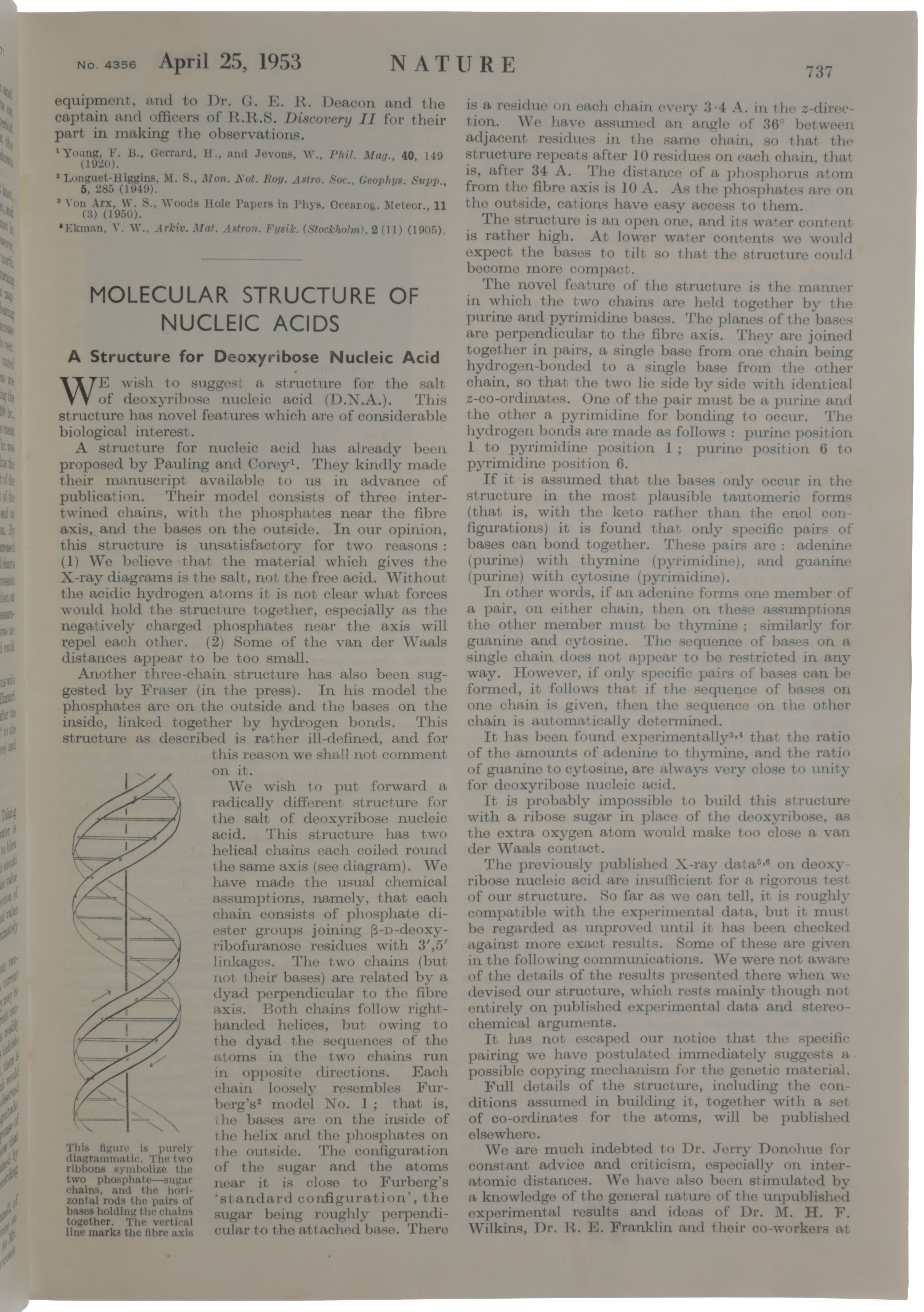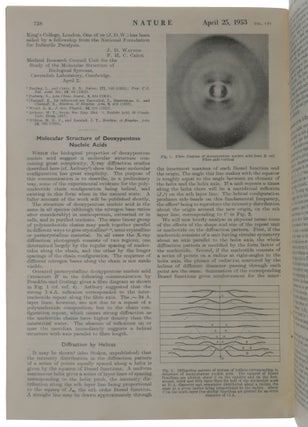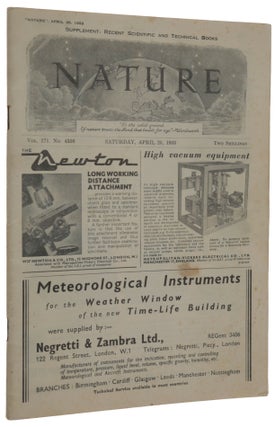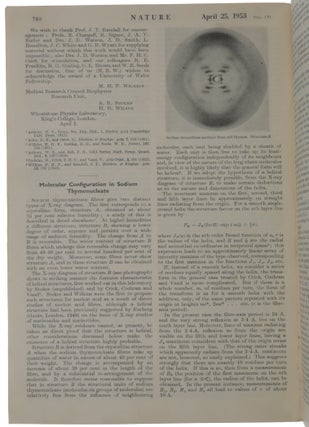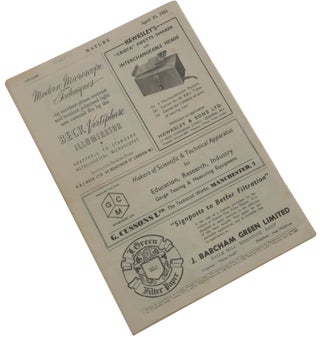‘Molecular Structure of Nucleic Acids: A Structure for Deoxyribose Nucleic Acid,’ pp. 737-738; WILKINS, M. H. F., STOKES, A. R. & WILSON, H. R. ‘Molecular Structure of Deoxypentose Nucleic Acids,’ pp. 738-740; FRANKLIN, R. E. & GOSLING, R. G. ‘Molecular Configuration in Sodium Thymonucleate,’ pp. 740-741. Three papers in: Nature, Vol. 171, No. 4356, April 25, 1953.
London: Macmillan, 1953. First edition, in the form in which it first appeared, of one of the most important scientific papers of the twentieth century, which “records the discovery of the molecular structure of deoxyribonucleic acid (DNA), the main component of chromosomes and the material that transfers genetic characteristics in all life forms. Publication of this paper initiated the science of molecular biology. Forty years after Watson and Crick's discovery, so much of the basic understanding of medicine and disease has advanced to the molecular level that their paper may be considered the most significant single contribution to biology and medicine in the twentieth century” (One Hundred Books Famous in Medicine, p. 362). The paper ended with one of the most famous understatements in the history of science: “It has not escaped our notice that the specific pairing we have postulated immediately suggests a possible copying mechanism for the genetic material.” The double helix describing the molecular structure of DNA has not only reshaped biology, it has become a cultural icon, represented in sculpture, visual art, jewellery, and toys. In 1962, Watson, Crick, and Wilkins shared the Nobel Prize in Physiology or Medicine “for their discoveries concerning the molecular structure of nucleic acids and its significance for information transfer in living material” (Franklin had died in 1958 and so was not eligible for the prize). This journal issue is actually much rarer at auction than the offprint. DNA was first isolated by the Swiss physician Friedrich Miescher in 1869, and over the succeeding years many researchers investigated its structure and function, with some arguing that it may be involved in genetic inheritance. In 1944 Oswald Avery, Maclyn McCarty, and Colin MacLeod published a paper showing how genes are composed of DNA, and Erwin Chargaff would observe that DNA contained equal amounts of adenine to thymine and of cytosine to guanine. But no one knew what it looked like or how it was copied. By the early 1950s this had become one of the most important questions in biology. After moving to King's College, London in 1947, Maurice Wilkins began research on the structure of DNA. In January 1951, Rosalind Franklin also moved to King's. Both worked on the structure of nucleic acids, but they clashed and one could not abide the other. Also working in King's were Alec Stokes and Bruce Fraser. By July 1951, Stokes had convincing mathematical evidence that DNA had a helical structure. In November 1951, Fraser built a model that turned out to have all the key elements correct—a helical shape, phosphates on the outside, and stacked bases separated by a distance of 3.4 angstroms—except for the number of chains. This research was completed before Watson began working with Crick. But neither Stokes nor Fraser published their findings. Having no one to talk to about his work, Wilkins discussed his frustrations—and research findings—with an old friend, Francis Crick, working at Cambridge University. Crick had a junior collaborator, James Watson, and the two had a warm and buoyant relationship in contrast to the antipathy between Franklin and Wilkins. Crick and Watson began their own investigation at the Cavendish Laboratory in Cambridge, in 1952, focusing on building molecular models. After one failed attempt in which they postulated a triple-helix structure, they were banned by the Cavendish from spending any additional time on the subject. On January 30, 1953, Watson visited King’s. Without Franklin’s permission, Wilkins showed her data to Watson—in particular, an X-ray crystallograph (of May 1952), the famous ‘Photo 51’ (which is reproduced in the third paper), that provided unquestionable evidence of the helical structure of DNA. The photograph struck Watson with the force of revelation. He sketched the pattern on the margin of his newspaper, and brought it back to Crick. Within four weeks, Watson and Crick had completed their model for the structure of DNA. In their published paper, they summarized their results as follows: “We wish to suggest a structure for the salt of deoxyribose nucleic acid (D.N.A.). This structure has novel features which are of considerable biological interest … This structure has two helical chains each coiled round the same axis … The novel feature of the structure is the manner in which the two chains are held together by the purine and pyrimidine bases … only specific pairs of bases can bond together. These pairs are: adenine (purine) with thymine (pyrimidine), and guanine (purine) with cytosine (pyrimidine).” In their paper, Watson and Crick, referred to the Fraser model but dismissed it as “rather ill-defined, and for this reason we shall not comment on it.” In developing their model, Watson and Crick never once touched or looked directly at a fibre of DNA. The article has no experiments, and consists of speculation based primarily on the experimental findings of the King’s researchers. In a footnote to a 1954 paper, ‘The complementary structure of deoxyribonucleic acid,’ (Proceedings of the Royal Society, Series A, 223, pp. 80–96), Crick and Watson wrote, “we wish to point out that without this data [King’s] the formulation of our structure would have been most unlikely, if not impossible”. And in 1999 Watson admitted, “the Franklin photograph was the key event”. “Although recognized today as one of the seminal scientific papers of the twentieth century, Watson and Crick’s original article in Nature was not frequently cited at first. Its true significance became apparent, and its circulation widened, only towards the end of the 1950s, when the structure of DNA they had proposed was shown to provide a mechanism for controlling protein synthesis, and when their conclusions were confirmed in the laboratory by Matthew Meselson, Arthur Kornberg, and others. “Crick himself immediately understood the significance of his and Watson’s discovery. As Watson recalled, after their conceptual breakthrough on February 28, 1953, Crick declared to the assembled lunch patrons at The Eagle that they had ‘found the secret of life.’ Crick himself had no memory of such an announcement, but did recall telling his wife that evening ‘that we seemed to have made a big discovery.’ He revealed that ‘years later she told me that she hadn’t believed a word of it.’ As he recounted her words, ‘You were always coming home and saying things like that, so naturally I thought nothing of it’” (Francis Crick Papers, National Library of Medicine, profiles.nlm.nih.gov/SC/Views/Exhibit/narrative/doublehelix.html) "When Watson and Crick’s paper was submitted for publication in Nature, Sir Lawrence Bragg, the director of the Cavendish Laboratory at Cambridge, and Sir John Randall of King’s College agreed that the paper should be published simultaneously with those of two other groups of researches who had also prepared important papers on DNA: Maurice Wilkins, A.R. Stokes, and H.R. Wilson, authors of ‘Molecular Structure of Deoxypentose Nucleic Acids,’ and Rosalind Franklin and Raymond Gosling, who submitted the paper ‘Molecular Configuration in Sodium Thymonucleate’” (ibid.). The Franklin and Gosling paper “reports Franklin’s discovery of the existence of DNA in two forms, and conditions for readily and rapidly changing from one to the other. Its phosphates were on the outside” (Maddox, Rosalind Franklin: The Dark Lady of DNA, p. 195); ‘Helical structure of crystalline deoxypentose nucleic acid’ by Wilkins, Stokes, Wilson and Seeds, contains the first independent confirmation of the Watson-Crick double-helix model, “suggest[ing] that proof is now available that dexoyribonucleic acid consists of two helical intertwined polynucleotide chains.” When Watson and Crick produced their double helix model of DNA, it was known that most of the specialized features of the many different life forms on Earth are made possible by proteins. Structurally, proteins are long chains of amino acid subunits. In some way, the genetic molecule, DNA, had to contain instructions for how to make the thousands of proteins found in cells. From the DNA double helix model, it was clear that there must be some correspondence between the linear sequences of nucleotides in DNA molecules to the linear sequences of amino acids in proteins. The details of how sequences of DNA instruct cells to make specific proteins was worked out by molecular biologists during the period from 1953 to 1965. Francis Crick played an integral role in both the theory and analysis of the experiments that led to an improved understanding of the genetic code. Other advances in molecular biology stemming from the discovery of the DNA double helix eventually led to ways to sequence genes. James Watson directed the Human Genome Project at the National Institutes of Health. The ability to sequence and manipulate DNA is now central to the biotechnology industry and modern medicine. Grolier Club, One Hundred Books Famous in Medicine, 99; Dibner, Heralds of Science, 200. Garrison-Morton 256.3, 7138 (Watson & Crick papers); 6847 (Franklin & Gosling paper); Judson, Eighth Day of Creation, pp. 145-56.
8vo (255 x 178 mm), pp. with diagram of the double helix and two illustrations from X-ray diffraction photographs. Stapled in original printed wrappers.
Item #5049
Price: $12,500.00

